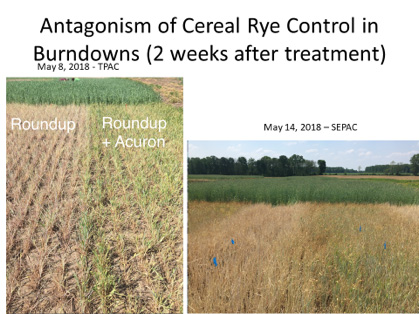We’ve received several calls this year about reduced herbicide efficacy, specifically with glyphosate and glyphosate mixtures when sprayed either during cool temperatures or just after a cold spell. This is not a new phenomena, but been accentuated this spring by the fact we had an extended cold spell through the middle and latter part of the spring when we are normally doing burn down treatments for our no till and cover crop acres. This year in particular, we had several growers experience challenges with glyphosate activity when tank mixed with atrazine or an atrazine premix. Fortunately, we had similar treatments one of cover crop trials that we are conducting at a couple of locations and were able to capture some good images and weather information around those treatments. The purpose of this article is to share our data and experiences with this situation in 2018.
We are conducting cover crop experiments at three different Purdue Agricultural Centers this year. One of the trial objectives is to look at the influence of termination timing on herbicide efficacy, weed suppression, and crop yields. Our cereal rye experiment provided a good data set to look at the influence of air temperatures on glyphosate and glyphosate plus atrazine activity. In table 1, we are showing the data for two of our sites, Throckmorton Purdue Agricultural Center (TPAC) near Lafayette Indiana and the Southeast Purdue Agricultural Center (SEPAC) near Butlerville, Indiana. In table 1 we can see the daytime high and low temperatures for the two days prior to spraying, spray day, and the next two days after that. At TPAC, you can see that the two days before spraying we had daytime air temps that got up in the 50s and 60s, But night time air temps that got as low as 29° on the day of spraying. The next two days after the spray treatment was made, our nighttime air temps got down as low as 29°. If we look at the SEPAC information you can see that the two days before spraying, and the day of spraying nighttime air temps or down in the 30s and low 40s. The day after spraying we had a nighttime low of 42.
In figure 1 you can see images from the two research sites. At both sites you can see that Roundup alone is providing more control then Roundup plus Acuron at two weeks after treatment. The common thread with these results is the influence of cool nighttime temperatures on herbicide activity. For many years we focused our attention mostly on daytime air temperatures and its influence on herbicide activity. In our data set, daytime are temps are mostly in the 50’s and above. However, over the last 8 to 10 years we have become more educated on the influence of nighttime air temps on herbicide activity. The moral of the story is that daytime air temperatures may seem ideal for herbicide activity, but night time air temperatures can cause plants to slow their growth rates or shut down. We know that if plants aren’t actively growing, herbicide efficacy is reduced for translocated herbicides. Our general rule of thumb is that we want daytime air temperatures in the 50s and 60s and nighttime temperatures in the 40s or higher to assure plants are actively growing to maximize the effectiveness of postemergence translocated herbicides.
Table 1. Low and high air temperatures (°F) for two days before termination application to two days after application.
| TPAC Low | TPAC High | SEPAC Low | SEPAC High | |
|---|---|---|---|---|
| 2 Days Before Application | 50 | 60 | 41 | 55 |
| 1 Day Before Application | 39 | 50 | 30 | 59 |
| Day Of Application | 29 | 65 | 33 | 71 |
| 1 Day After Application | 29 | 65 | 42 | 80 |
| 2 Days After Application | 35 | 54 | 59 | 82 |

Figure 1. Picture of Roundup alone compared to Roundup + Acuron two weeks after herbicide application to terminate cereal rye.


